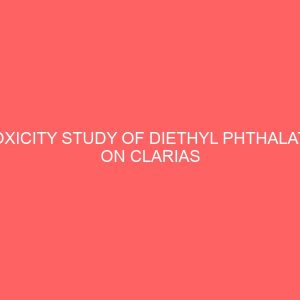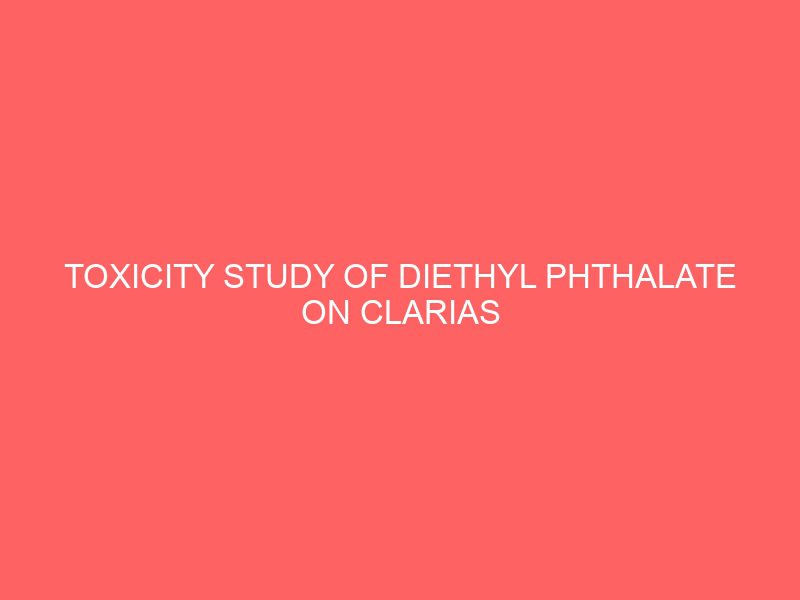Description
CHAPTER ONE
INTRODUCTION
Diethyl phthalate (C12H1404) is a man made colourless liquid with a slight aromatic odour, bitter and disagreeable taste. Its relative molecular mass is 222.3. The trade name of diethyl phthalate includes neantine, peilantol A, and solvanol. Its structural formula is given in Fig.1. Fig.1. Structure of diethyl phthalate O C – O – CH2 CH3 (ATSDR, 1995) C – O – CH2 CH3 0 O 2 Table 1: Physiological properties of diethyl phthalate (Agency for toxic substances and Disease registry (ATSDR) (1989)) a From Hazardous Substance Data Bank (1994) b Temperature not specified. c Assuming a temperature for the dimensioned value at around 20Ëš C. Property Value Water solubility 1000 mg/litre Solubility in organic solvents Soluble in alcohol, acetone, ether, benzene, ketones, esters, aromatic, hydrocarbons, aliphatic solvents and vegetable oil. Partition Coefficients Log Kocb 2.65 Vapour pressure at 20°C 4.59×10-2pa at 28o C 2.19×10-1pa Henry’s law constantb 7.9×10-5 kpa Dimensionless Henry’s law constant (Air/water pollution coefficient)c 4.310-8 3 Diethyl phthalate is produced industrially by the reaction of phthalic anhydride with ethanol in the presence of concentrated sulfuric acid catalyst (HSDB, 1994). The purity of manufactured phthalate esters is reportedly between 99.70% and 99.97%, with the main impurities being isophthalic acid, tetephthalic acid, and maleic anhydride (Peakall, 1975). Diethyl phthalate is manufactured for many uses such as insecticide, mosquito repellants, as a camphor substitute, plasticizer for cellulose ester plastic films and sheets, bathing soaps, cosmetics, aftershave lotion, hair sprays, nail polish and enamel removers, eye shadow, perfumes, detergent, skincare preparation, etc. (Kamrin and Mayor, 1991). Diethyl phthalate may enter the environment in industrial wastewaters by evaporation into the air from disposal sites, directly from consumer products, burning of plastic products and by leaking from landfills into soil or water including ground water (ATSDR, 1995). It may also be deposited on the ground or in the water by rain. In more slowly moving waters, microorganism in the water or sediment may break down some of the deadly phthalate into nontoxic products. However, if there is a little organic matter in the soil, diethyl phthalate may move down through the soil and enter the ground water. Small amount of diethyl phthalate can build up in animals that live in such waters like fish, oyster, etc. Based on 1994 toxics release inventory data, USEPA, (1995) estimated that 72 tonnes and 341 kg of diethyl phthalate would be released annually. Diethyl phthalate is likely to undergo biodegradation in the environment. The abiotic degradation processes such as hydrolysis, oxidation, and photolysis are unlikely to play significant role in the environmental fate of diethyl phthalate (US EPA, 1979). 4 Volatilization of diethyl phthalate is expected to be slow based on its low vapour pressure of 4.59 x 102 at 20° C (Grayson and Fosbraey, 1982). Diethyl phthalate reacts photochemically with hydroxyl radicals in the air, with an estimated half-life of 2 – 22 h (HSDB, 1994). The distribution of diethyl phthalate between the gaseous and particulate phases in air has been estimated by the Jungle Pankow model, which determines the fraction of diethyl phthalate in the particulate creosol phase to be 0.00039 (Staples et al., 1997). However, it has been estimated that approximately 1% of the phthalate ester content of plastics materials in direct contact with water or other liquids may be released into the aquatic environment (Peakall, 1975). Diethyl phthalate can absorb into suspended particles in marine waters with the maximum occurring into particles ranging 353 – 698 ïm in size (Al-Omran and Preston, 1987). Diethyl phthalate have been detected in aquatic organisms and have been found to bioconcentrate modestly in these organisms (Camanzo et al., 1983; Devault, 1985; Mcfall et al., 1985). Biodegradation of diethyl phthalate in soil has been shown to occur as a series of sequential steps. 0.1-100 mg/g of diethyl phthalate with a half life of 0.75 days at 20°C was biodegraded rapidly in soil and was not expected to persist in the environment (Cartwright et al., 2000b). Diethyl phthalate has been detected in ambient in-door air waste waters from industrial facilities, subspace waters and sediments, and marine waters. Diethyl phthalate has been measured in the indoor air of a telephone switching office and in out door air in Newark, USA, at a concentration ranging from 1.60 to 2.30 ïg/m3 and from 0.40 to 0.52 ïg/m3 respectively, during a 43-day sample period (Shields and Weschler, 1987). Diethyl phthalate has been detected in treated waste waters from various manufacturing plants. For example 3.2 ïg/liter was detected at textile manufacturing 5 plants (Walsh et al., 1980), 60 ïg/litre was detected at a tyre manufacturing plant (Jungclaus et al., 1976), and 50 ïg/litre was detected at a pulp and paper manufacturing plant (Brownlee and Strachan; 1977, Voss, 1984). Diethyl phthalate has been found at a median concentration of < 10 ïg/L in 10% of the industrial effluent samples and in 3.0% of the ambient water samples in the storage and retrieval (STORET) database maintained by the US Environmental Protection Agency (EPA) (Staples et al, 1985). A river water sample from the lower Tennessee River, USA, was found to contain diethyl phthalate at a concentration of 11.2 ïg/l (Goodley and Gordon, 1976) and 21 ïg/litre in tap water from the Kitakyushu area of Japan. The source of exposure was considered to be domestic sewage and industrial waste (Akiyama et al, 1980). River water samples and sewage effluent collected in 1984 from the Rivers Irwell and Etherow near Manchester, England, contained 0.4 – 0.6 ïg/l diethyl phthalate (Futoki and Vernon, 1990). Diethyl phthalate was detected in 10% of aquatic sediment samples at a median concentration of < 2.5 mg/kg wet weight (Staples et al., 1985). Diethyl phthalate was detected in 4.26% of the soil samples taken from the U.S. National Priorities List of Hazardous Waste Sites, at a mean concentration of 39 mg/kg in the positive samples (Contract Laboratories Programme Statistical Data Base, 1989). Human exposure to diethyl phthalate can result from eating foods into which diethyl phthalate has leached from packaging materials, eating contaminated sea food, drinking contaminated water, breathing contaminated air or as a result of medical treatment involving the use of PVC tubing for example dialysis of patient (Blount et al., 2000b). The use of diethyl phthalate as an ingredient in a variety of cosmetic formulations at concentrations raging from < 0.1% to 28.6% however, are likely to be the primary sources of human exposure (Api, 2001). A 2001 survey of fragrance manufacturers in the USA provided maximum concentrations of 1 – 11% diethyl phthalate in perfume, 1.0% in deodorants, and other 6 personal cleanliness products, (Anonymous, 1985). The products when applied to skin, eyes, hair, and nails will come in contact with mucous membranes and with the respiratory tract frequently and for prolonged duration (Kamrin and Mayor. 1991). Diethyl phthalate was detected in 42% of the human adipose tissue samples from children and adults (cadavers and surgical patients) in various regions of the USA during 1982 (USEPA, 1986). Diethyl phthalate was detected in 1 of 1 drinking water sample, 1 of 8 ambient air sample and 2 of 12 exhaled breath samples. Diethyl phthalate concentrations ranging from 0.01 ïg/l (in 6 of 10 US cities) to 1.0 ïg/litre (in Miami, Florida) were found in drinking water samples from water treatment plants in the USA (Keith et al., 1976).Diethyl phthalate is not known to cause cancer in humans or animal. It can however be mildly irritating when applied to the skin of animals. Freshwater fish collected from the Great Lake tributaries in Wisconsin and Ohio, USA, in 1981, contained diethyl phthalate in composite whole body tissue samples at concentration ranging from < 0.02 mg/kg to < 0.30 mg/kg (Devault, 1985). Lake trout (Salvelinus namaycush) and white fish (Coregonus clupeaformis) taken from Lake Superior near Isle Royale, Michigan, USA, had elevated levels of diethyl phthalate (0.5 and 2.2 ïg/g, respectively compared with lake trout and white fish taken from other part of Lake Superior (US EPA, 1980). Fish taken from Siskiwit Lake on Isle Royale, Michigan, a pristine area supposedly unaffected by human activity, also had relatively high concentrations of diethyl phthalate in their tissue, 0.4 mg/kg for lake trout and 1.7 mg/kg for white fish. However, diethyl phthalate has been seen to be toxic to the environment and most especially the aquatic organism found in aquatic environment. The effect of different 7 doses of diethyl phthalate on histopathology and haematological parameters has not been studied earlier. This study therefore aims at investigating the acute and chronic effect of this compound, diethyl phthalate on the enzymatic activities and haematology. To be studied are haematological parameters such as haemoglobin, packed cell volume, red blood cell count, white blood cell count, differential count, and histopathology of the fish liver, kidney, and gills. It is justified to embark on these further studies so as to check the extent of damage done in a dose of dependent manner at given point in time following the administration of the compound on the fishes. 1.2 Aims of Study The objectives of this study were to: 1. Determine whether the compound diethyl phthalate is lethal to test organism Clarias gariepinus (Burchell, 1882) and at what concentration the number of half the treated fish would die; 2. Determine the effect of this chemical on their biochemical parameters; and 3. Check the effects of diethyl phthalate on haematological parameters and histopathology of the test organism when exposed to sublethal concentrations. 1.3 Literature Review Diethyl phthalate has been found to be used as a component in insecticide sprays and mosquito repellents and has been shown to have deleterious effects in animals and aquatic organism such as fish etc. (Devault, 1985). A study on toxicity of diethyl phthalate in rats was shown when diethyl phthalate (10 or100mg) was administered to 8 each three Wister rats by stomach intubations. Their daily urine collections were analyzed for 10 days by Gas chromatography (Kawano, 1980). Seventy seven to seventy eight percent of the administered dose was excreted in urine within 24 hours as monoester derivatives (67 – 70% of the dose), phthalic acid (8 – 9% of the dose) and about 35 – 93% was excreted within 11 weeks after administration. Male rats exposed to a single dermal application of 14C diethyl phthalate (5 – 8 mg/cm2) excreted 24% of the administered dose in the urine and 1% dose in faeces within 24h (Elsisi et al., 1989). Studies have reported increase in absolute and relative liver weights in rats after 1-16 weeks of exposure of diethyl phthalate (Brown et al., 1978; Moody and Reddy, 1978; Oishi and Hiraga, 1980). According to NTP (1995) in a 4-week study, diethyl phthalate was dermally applied to rats. A Group of 10 male and 10 female rats were administered with 0 ml, 35 ml, 75 ml, 150ml and 300ml of diethyl phthalate (corresponding to 0, 200, 400, 800, or 1600 mg/kg for males and 0, 300, 600, 1200 or 2500 mg/kg body weight per day for females. Increased relative weights were observed in 300 ml (male 9% and Female rats 7%). However, no adverse effects on the histopathology of heart, lung, liver, kidney, esophagus, gall bladder, large intestine, small intestine and stomach in rats were observed (NTP, 1995). A comparison of the results of in vitro mutagenic assays of diethyl phthalate in strains of Salmonella typhimurium shows contradictory findings. Diethyl phthalate has been shown to be mutagenic for S. typhimurium strains TA100 and TA 1535 only without metabolic activation (Kozumbo et al., 1982; Agarwal et al., 1985). The maximum ratio of induced revertants to control was about 2 – 3 (Kozumbo et al., 1982; Agarwal et al., 1985) and about 2 (Agarwal et al., 1985) for TA100 and TA1535, respectively. No induced revertants were observed for TA98 and TA1537 with or without metabolic activation (Rubin et al., 1979). Contrary to positive findings, diethyl phthalate has been 9 found to be non-mutagenic in S. typhimurium strains TA98, TA 100, TA1537 with or without metabolic activation (Zeiger et al., 1982). Chronic toxicity studies were performed with commercial phthalate esters on Daphnia magma (14 phthalates) and rainbow trout (Oncorhynchus mykiss ) using the lower molecular-weight phthalate esters – dimethylphthalate (DMP), diethyl phthalate (DEP), di-n- butyl phthalate (DBP), and butylbenzylphthalate (BBP). The results of the studies indicated a general trend to which toxicity for both species increased as water solubility decreased. Early life-stage toxicity studies with rainbow trout indicated that survival (DMP) and growth (DBP) were affected at 2.1 and 0.19 mg/l, respectively (Jon et al., 1994). Preliminary results of quantitative structure-activity relationship (QSAR) showed acute toxicity of fathead minnow (Pimephales promelas) for phthalate esters. The result showed that 10 mg/L < LC50 < 100 mg/L was harmful, 1 mg/L < LC50 <10 mg/L was toxic; LC50 < 1 mg/L was very toxic. This prediction effort resulted in classification of the vast majority of the phthalates in the very toxic group (Parkerton and Konkel, 2000). Nivedita et al., (2002) report on the toxic effect of diethyl phthalate on Cirrhina mrigala indicated that DEP brings about significant changes in the activity of certain liver and muscle enzyme and at 75 ppm DEP (w/v) 100% mortality occurred within 24h. However, the alteration in enzyme activity may have long term effect when DEP is introduced in low doses. Fatoki and Vernon (1990) opined that when the enzyme activities in vital organs of fishes are altered due to long exposure, it may be dangerous to the fishes and their survival is at risk. 10 Table 2: Data on acute toxicity (mg/L) of some phthalate esters on fish* Chemical Sheephead minnowflow through 96 h Rainbow troutflow through 96 h Bluegill static 96h Fathead minnow static 96h Fathead minnow, flow through 96 h Di-methyl phthalate** 29 56 67 120 39 Diethyl phthalate** 99 12 22 17 17 Butyl benzyl phthalate NATBLS NATBLS 15 Butly-2-ethylhexyl phthalate NATBLS NATBLS NATBLS NATBLS NATBLS (ATSDR, 1989) 11 Table 3. Toxicity of diethyl phthalate to fish (ATSDR, 1995) *NOEC- no observed effective concentration 1.4 Brief Description and Taxonomy of Clarias gariepinus Clarias gariepinus is an omnivorous bottom feeder, feeding on detritus, plankton, insect larvae, worms, gastropods, crustacean and small fishes such as Tilapia and Alestes. Abundance: It is an indigenous species in Africa. It is most abundant and widely distributed in African lakes and rivers e.g. River Nile. It naturally inhabits in tropical swamps, lakes, rivers and flood plains. It is naturally called Africa magur. In recent years Name of fish End point Concentration (mg/L) Blue Gill (Lepomis macrochirus) 96-h LC50 98 96-h NOEC* 1.7 Rainbow trout (Oncorhynchus mykiss) 96-h LC50 12 96-h NOEC 3.8 Fat head minnow (Pimephales promelas) 96-h LC50 17 96-h NOEC 4 Golden orfe (Leuciscus idus melanotus) 48-h LC50 53-61 Sheep head minnow (Cyprinodont variegates) 96–h LC50 30 96–h LC50 29 96-h NOEC 20 12 it has been introduced in Europe, Asia and South American. There are about 13 genera and 100 species of clariids (Idodo-Umeh, 2003). Utilization: (1) The flesh is of high quality, greatly prized and consumed by many people. (2) It is cultured artificially in fish ponds or enclosures. (3) Big-sized Clarias gariepinus is usually used to control the population of tilapia when cultured together (Idodo-Umeh, 2003).







